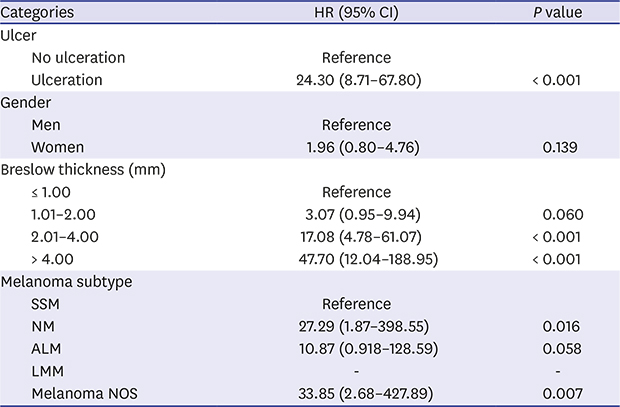1. Usher-Smith JA, Emery J, Kassianos AP, Walter FM. Risk prediction models for melanoma: a systematic review. Cancer Epidemiol Biomarkers Prev. 2014; 23(8):1450–1463.


3. Uysal-Sonmez O, Tanriverdi O, Esbah O, Uyeturk U, Helvaci K, Bal O, et al. Multicenter evaluation of patients with cutaneous malignant melanoma in Turkey: MELAS study. Asian Pac J Cancer Prev. 2013; 14(1):533–537.


4. Metelitsa AI, Dover DC, Smylie M, de Gara CJ, Lauzon GJ. A population-based study of cutaneous melanoma in Alberta, Canada (1993–2002). J Am Acad Dermatol. 2010; 62(2):227–232.


5. Haenssle HA, Hoffmann S, Buhl T, Emmert S, Schön MP, Bertsch HP, et al. Assessment of melanoma histotypes and associated patient related factors: basis for a predictive statistical model. J Dtsch Dermatol Ges. 2015; 13(1):37–45.


6. Shoo BA, Kashani-Sabet M. Melanoma arising in African-, Asian-, Latino- and Native-American populations. Semin Cutan Med Surg. 2009; 28(2):96–102.


7. Cress RD, Holly EA. Incidence of cutaneous melanoma among non-Hispanic whites, Hispanics, Asians, and blacks: an analysis of California cancer registry data, 1988–93. Cancer Causes Control. 1997; 8(2):246–252.

8. Bellew S, Del Rosso JQ, Kim GK. Skin cancer in Asians: part 2: melanoma. J Clin Aesthet Dermatol. 2009; 2(10):34–36.


10. Fang S, Wang Y, Dang Y, Gagel A, Ross MI, Gershenwald JE, et al. Association between body mass index, C-reactive protein levels, and melanoma patient outcomes. J Invest Dermatol. 2017; 137(8):1792–1795.


11. Homolak D, Šitum M, Čupić H. Clinico-pathological features of patients with melanoma and positive sentinel lymph node biopsy: a single institution experience. Acta Dermatovenerol Croat. 2015; 23(2):122–129.

13. Zitelli JA, Brown CD, Hanusa BH. Surgical margins for excision of primary cutaneous melanoma. J Am Acad Dermatol. 1997; 37(3 Pt 1):422–429.


14. Chevalier V, Barbe C, Le Clainche A, Arnoult G, Bernard P, Hibon E, et al. Comparison of anatomical locations of cutaneous melanoma in men and women: a population-based study in France. Br J Dermatol. 2014; 171(3):595–601.

15. Park KD, Lee SJ, Lee WJ, Kim DW, Chung HY, Cho BC. Clinicopathological features of cutaneous malignant melanoma. Korean J Dermatol. 2007; 45(2):149–158.
18. Lee WJ, Lee YJ, Shin HJ, Won CH, Chang SE, Choi JH, et al. Clinicopathological significance of tumor-infiltrating lymphocytes and programmed death-1 expression in cutaneous melanoma: a comparative study on clinical subtypes. Melanoma Res. 2018; 28(5):423–434.


19. Ishihara K, Saida T, Yamamoto A. Japanese Skin Cancer Society Prognosis and Statistical Investigation Committee. Updated statistical data for malignant melanoma in Japan. Int J Clin Oncol. 2001; 6(3):109–116.


20. Chang JW, Yeh KY, Wang CH, Yang TS, Chiang HF, Wei FC, et al. Malignant melanoma in Taiwan: a prognostic study of 181 cases. Melanoma Res. 2004; 14(6):537–541.


21. Kim JH, Park JH, Lee DY. Site distribution of cutaneous melanoma in South Korea: a retrospective study at a single tertiary institution. Int J Dermatol. 2015; 54(1):e38–9.

22. Lee MW, Koh JK, Kwon KS, Kim NI, Kim SW, Kim SN, et al. Clinical and histopathological study of cutaneous melanoma in Korea. Korean J Dermatol. 2003; 41(1):43–47.
24. Jung HJ, Kweon SS, Lee JB, Lee SC, Yun SJ. A clinicopathologic analysis of 177 acral melanomas in Koreans: relevance of spreading pattern and physical stress. JAMA Dermatol. 2013; 149(11):1281–1288.

27. Barth A, Wanek LA, Morton DL. Prognostic factors in 1,521 melanoma patients with distant metastases. J Am Coll Surg. 1995; 181(3):193–201.

29. Sandru A, Voinea S, Panaitescu E, Blidaru A. Survival rates of patients with metastatic malignant melanoma. J Med Life. 2014; 7(4):572–576.


30. Sloan AE, Nock CJ, Einstein DB. Diagnosis and treatment of melanoma brain metastasis: a literature review. Cancer Contr. 2009; 16(3):248–255.

31. Liu W, Dowling JP, Murray WK, McArthur GA, Thompson JF, Wolfe R, et al. Rate of growth in melanomas: characteristics and associations of rapidly growing melanomas. Arch Dermatol. 2006; 142(12):1551–1558.

32. Sergentanis TN, Antoniadis AG, Gogas HJ, Antonopoulos CN, Adami HO, Ekbom A, et al. Obesity and risk of malignant melanoma: a meta-analysis of cohort and case-control studies. Eur J Cancer. 2013; 49(3):642–657.


33. Shipman AR, Millington GW. Obesity and the skin. Br J Dermatol. 2011; 165(4):743–750.


34. de Giorgi V, Gori A, Papi F, Grazzini M, Rossari S, Verdelli A, et al. Excess body weight and increased Breslow thickness in melanoma patients: a retrospective study. Eur J Cancer Prev. 2013; 22(5):480–485.

35. Skowron F, Bérard F, Balme B, Maucort-Boulch D. Role of obesity on the thickness of primary cutaneous melanoma. J Eur Acad Dermatol Venereol. 2015; 29(2):262–269.


36. de Giorgi V, Gori A, Grazzini M, Rossari S, Longo AS, Oranges T, et al. Obesity and melanoma. Br J Dermatol. 2012; 166(6):1357–1358.


38. Brandon EL, Gu JW, Cantwell L, He Z, Wallace G, Hall JE. Obesity promotes melanoma tumor growth: role of leptin. Cancer Biol Ther. 2009; 8(19):1871–1879.

39. Pandey V, Vijayakumar MV, Ajay AK, Malvi P, Bhat MK. Diet-induced obesity increases melanoma progression: involvement of Cav-1 and FASN. Int J Cancer. 2012; 130(3):497–508.


40. Hutchinson PE, Osborne JE, Pringle JH. Higher serum 25-hydroxy vitamin D3 levels at presentation are associated with improved survival from melanoma, but there is no evidence that later prevailing levels are protective. J Clin Oncol. 2010; 28(27):e492–e493.















 PDF
PDF Citation
Citation Print
Print




 XML Download
XML Download